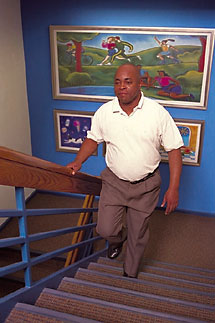StairWELL to Better Health
Taking the stairs is one way to be more physically active. At work, employees are often presented with a choice between taking the stairs and taking an elevator or escalator. Choosing the stairs instead of the elevator is a quick way for people to add physical activity to their day.
Using the stairs requires little additional time, no wardrobe change, and few additional costs because building code requires stairs. If your building has a staircase, why not start using it now?
One of the reasons employees may not use the stairs as work is because
they perceive them as unattractive and/or unsafe. CDC’s Division of Nutrition, Physical Activity and Obesity conducted a study beginning in 1998 to see if
making physical changes to a stairwell in the Atlanta-based Koger Center
Rhodes Building, combined with music and motivational signs would motivate
employees to use the stairs. A four-stage passive intervention was
implemented over 3½ years that included painting and carpeting, framed
artwork, motivational signs, and music. Infrared beams were used to track
the number of stair users. "StairWELL to Better Health" was a low-cost
intervention (less than $16,000*), and the data suggest that physical
improvements, motivational signs, and music can increase stairwell use among building occupants.**
 |
|
|
Photo by Stephen Grote |
This section will provide the information you need to transform your stairs into StairWELLs for better health. The following topics are addressed in this section:
- Stairwell Appearance
- Motivational Signs
- Installing Music
- Other Ideas to Consider
- Tracking Stair Usage
- Project Checklist
- Related Resources
*This amount included the purchase of paint, carpet, rubber treading, picture frames, artwork, signage and installation of music.
** Kerr, N.A., Yore, M.M., Ham, S.A., & Dietz, W.H. (2004). Increasing Stair Use in a Worksite Through Environmental Changes. American Journal of Health Promotion, 18 (4): 312–315.
![]() Please note: Some of these publications are available for download only as *.pdf files. These files require Adobe Acrobat Reader in order to be viewed. Please review the information on downloading and using Acrobat Reader software.
Please note: Some of these publications are available for download only as *.pdf files. These files require Adobe Acrobat Reader in order to be viewed. Please review the information on downloading and using Acrobat Reader software.
* Links to non-Federal organizations found at this site are provided solely as a service to our users. These links do not constitute an endorsement of these organizations or their programs by CDC or the Federal Government, and none should be inferred. CDC is not responsible for the content of the individual organization Web pages found at these links.
Page last updated: May 22, 2007
Content Source: Division of Nutrition, Physical Activity and Obesity, National Center for Chronic Disease Prevention and Health Promotion

